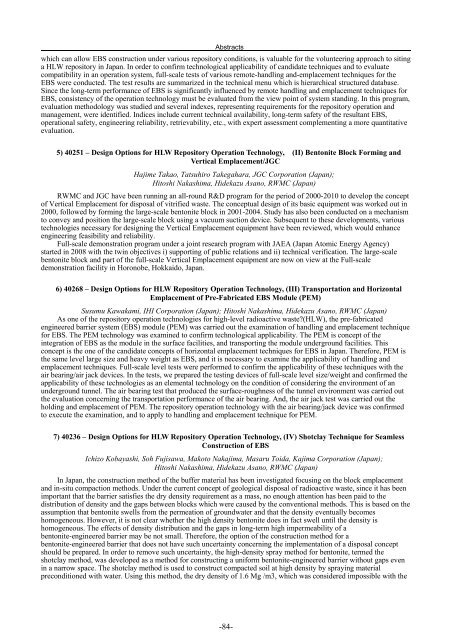ASME Message
ASME Message
ASME Message
Create successful ePaper yourself
Turn your PDF publications into a flip-book with our unique Google optimized e-Paper software.
Abstracts<br />
which can allow EBS construction under various repository conditions, is valuable for the volunteering approach to siting<br />
a HLW repository in Japan. In order to confirm technological applicability of candidate techniques and to evaluate<br />
compatibility in an operation system, full-scale tests of various remote-handling and-emplacement techniques for the<br />
EBS were conducted. The test results are summarized in the technical menu which is hierarchical structured database.<br />
Since the long-term performance of EBS is significantly influenced by remote handling and emplacement techniques for<br />
EBS, consistency of the operation technology must be evaluated from the view point of system standing. In this program,<br />
evaluation methodology was studied and several indexes, representing requirements for the repository operation and<br />
management, were identified. Indices include current technical availability, long-term safety of the resultant EBS,<br />
operational safety, engineering reliability, retrievability, etc., with expert assessment complementing a more quantitative<br />
evaluation.<br />
5) 40251 – Design Options for HLW Repository Operation Technology, (II) Bentonite Block Forming and<br />
Vertical Emplacement/JGC<br />
Hajime Takao, Tatsuhiro Takegahara, JGC Corporation (Japan);<br />
Hitoshi Nakashima, Hidekazu Asano, RWMC (Japan)<br />
RWMC and JGC have been running an all-round R&D program for the period of 2000-2010 to develop the concept<br />
of Vertical Emplacement for disposal of vitrified waste. The conceptual design of its basic equipment was worked out in<br />
2000, followed by forming the large-scale bentonite block in 2001-2004. Study has also been conducted on a mechanism<br />
to convey and position the large-scale block using a vacuum suction device. Subsequent to these developments, various<br />
technologies necessary for designing the Vertical Emplacement equipment have been reviewed, which would enhance<br />
engineering feasibility and reliability.<br />
Full-scale demonstration program under a joint research program with JAEA (Japan Atomic Energy Agency)<br />
started in 2008 with the twin objectives i) supporting of public relations and ii) technical verification. The large-scale<br />
bentonite block and part of the full-scale Vertical Emplacement equipment are now on view at the Full-scale<br />
demonstration facility in Horonobe, Hokkaido, Japan.<br />
6) 40268 – Design Options for HLW Repository Operation Technology, (III) Transportation and Horizontal<br />
Emplacement of Pre-Fabricated EBS Module (PEM)<br />
Susumu Kawakami, IHI Corporation (Japan); Hitoshi Nakashima, Hidekazu Asano, RWMC (Japan)<br />
As one of the repository operation technologies for high-level radioactive waste?(HLW), the pre-fabricated<br />
engineered barrier system (EBS) module (PEM) was carried out the examination of handling and emplacement technique<br />
for EBS. The PEM technology was examined to confirm technological applicability. The PEM is concept of the<br />
integration of EBS as the module in the surface facilities, and transporting the module underground facilities. This<br />
concept is the one of the candidate concepts of horizontal emplacement techniques for EBS in Japan. Therefore, PEM is<br />
the same level large size and heavy weight as EBS, and it is necessary to examine the applicability of handling and<br />
emplacement techniques. Full-scale level tests were performed to confirm the applicability of these techniques with the<br />
air bearing/air jack devices. In the tests, we prepared the testing devices of full-scale level size/weight and confirmed the<br />
applicability of these technologies as an elemental technology on the condition of considering the environment of an<br />
underground tunnel. The air bearing test that produced the surface-roughness of the tunnel environment was carried out<br />
the evaluation concerning the transportation performance of the air bearing. And, the air jack test was carried out the<br />
holding and emplacement of PEM. The repository operation technology with the air bearing/jack device was confirmed<br />
to execute the examination, and to apply to handling and emplacement technique for PEM.<br />
7) 40236 – Design Options for HLW Repository Operation Technology, (IV) Shotclay Technique for Seamless<br />
Construction of EBS<br />
Ichizo Kobayashi, Soh Fujisawa, Makoto Nakajima, Masaru Toida, Kajima Corporation (Japan);<br />
Hitoshi Nakashima, Hidekazu Asano, RWMC (Japan)<br />
In Japan, the construction method of the buffer material has been investigated focusing on the block emplacement<br />
and in-situ compaction methods. Under the current concept of geological disposal of radioactive waste, since it has been<br />
important that the barrier satisfies the dry density requirement as a mass, no enough attention has been paid to the<br />
distribution of density and the gaps between blocks which were caused by the conventional methods. This is based on the<br />
assumption that bentonite swells from the permeation of groundwater and that the density eventually becomes<br />
homogeneous. However, it is not clear whether the high density bentonite does in fact swell until the density is<br />
homogeneous. The effects of density distribution and the gaps in long-term high impermeability of a<br />
bentonite-engineered barrier may be not small. Therefore, the option of the construction method for a<br />
bentonite-engineered barrier that does not have such uncertainty concerning the implementation of a disposal concept<br />
should be prepared. In order to remove such uncertainty, the high-density spray method for bentonite, termed the<br />
shotclay method, was developed as a method for constructing a uniform bentonite-engineered barrier without gaps even<br />
in a narrow space. The shotclay method is used to construct compacted soil at high density by spraying material<br />
preconditioned with water. Using this method, the dry density of 1.6 Mg /m3, which was considered impossible with the<br />
-84-


